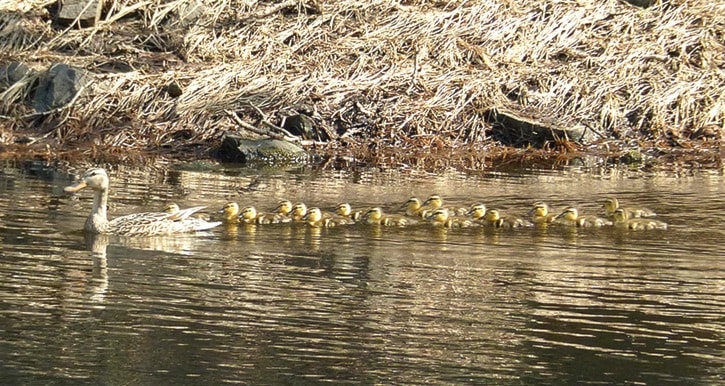Those that spend more time in the outdoors seem to have a greater connection with what goes on there. Their recollections and experiences, connected with goings on and things in the natural world, are much more extensive and varied than the memories and connections of people who spend the majority of their time inside — inside a dwelling, a building, a vehicle and so forth. For example, I think of farmers, who for the most part, have spent or spend most of their time outside. They have accounts of happenings and wild things that to many city people, who are “amputated” from their natural environment, sound like tall tales. Things that are everyday events in the life of a mallard duck may seem impossible or exaggerated.
Last week, I was driving south on Northwest Boulevard in fairly busy traffic. Shortly, there were a couple of vehicles slowing to a stop ahead of me, just south of the A&W. I wondered why the holdup. There, nearly in the middle of the road, was a mallard hen heading across the road toward the railway tracks. I checked to see if there were any young in tow. Sure enough, there were six or so almost egg-sized ducklings stirring about at the edge of the pavement. At the barely visible yellow line, the hen turned around and seemed to have “said” something, at which the young, in a tight group, scooted toward her, in front of stopped vehicles in both directions. I never saw them again after the mother splashed her way straight through a mud puddle, followed by her little tribe.
As I continued driving I thought about the event and realized those little mallards have to cross the railway track to get to water. They were just a fraction of the height of a rail, so I turned around and went back to “help” them get over the tracks. After carefully looking for them, trying to jump the rail, I didn't see anybody anywhere. They must have come to the rail and propelled themselves over it with their stubby little wings, flapping like only baby ducks can do.
Goslings and mallard ducklings are frequently seen crossing roadways this time of year. In fact, if I recall correctly, there have been at least two times when I have, in previous years, seen them cross at that same location. Where had the female nested?
Once in central Ontario, when looking for Oeneis chrxyus strigulosus (How would you like that for name?), I flushed a mallard or black duck hen from a nest in the grass, a long way from water. I think it had nine eggs. It was after that I found out a little more about mallard nesting and learned that they had been known to nest up to two miles from water, a lot more water than in the birdbath. Perhaps they even nest farther than that from water. Where will mallards nest?
Once it was reported to me that some sort of dragon or reptile was seen crossing my driveway. They narrated to me the details to help me identify this odd creature. Each segment of the creature was just like the front segment, except much smaller. (People do that to me, tell me tall tales.) Well, it was revealed to dumbfounded me, before I had a chance to answer, that it was a mallard hen trailing eight or so freshly hatched babies tail tip to beak tip, heading for water, perhaps nearly two miles away.
Now, we know that geese will use nests of osprey built on railway bridges and nests of other large birds built in even some very tall trees. But it is less often we hear of mallards nesting in trees. Once, a couple living on a farm on the wide-open prairie told me a mallard nested, regularly, in one of the spruce trees by their home. As some trees go in Alberta, this one was not very high. This farmstead had very few trees and the mallard hen chose a spot eight feet up in the top of this spruce. It may have been built on an old crow nest.
Ducks do nest in trees in a different sort of way. These are the tree cavity nesters. Wood ducks, for which people build wood duck boxes, hooded mergansers, golden-eye, bufflehead and so forth are examples. I don’t know of any mallard hens nesting in tree cavities. Have you seen that? (A family of great horned owls, yearly, has been raised in a bank burrow to the south of here.) Perhaps mallards may nest in the hollow of the top of a broken off tree. Don’t ever think, for a moment, that mallard hens or any other living things follow man’s “rules”.
You can probably think up your own stories along this line. When you think you have it figured out, then something different happens. It took more than a biochemist or neurological engineer to set in place the versatility and adaptability capabilities of wild things. It took the Master of all biochemists and neurological engineers to set in place the versatility and adaptability seen in even mallard hens!
Ed McMackin is a biologist by profession but a naturalist and hiker by nature. He can be reached at 250-866-5747.
